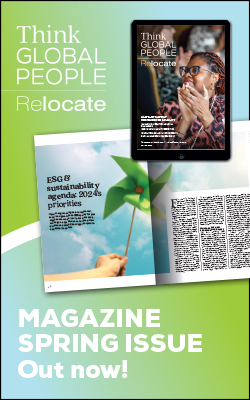Cracking the glass ceiling – what are the opportunities and challenges for women in a new world of hybrid working?
Hybrid working has brought many opportunities, enabling people to reassess their work-life balance, enjoy more time with their family and reduce the cost of commuting. However, there are also disadvantages to working alone – missing chances to network, promote yourself, be mentored and be inspired by other colleagues and leaders.

Why international assignments are life-changing and can add value to an organisations
The EY 2023 Mobility Reimagined Survey shows that mobility within organisations can attract and retain talent, but that many companies fall short of the ideal when offering opportunities to staff.The survey found that new ways of working — across borders and jurisdictions — have brought greater expectations for workforce flexibility, talent strategy, and technological investment, amid increasingly complex economic, geopolitical and social challenges.However, leaders need to consider how they mitigate risk in this context and enhance employee experience regardless of assignment location. The survey reveals that workforce mobility programs have powerful strategic and operational importance in the global race for talent. Yet traditional mobility models are often not built for the flexible and hybrid working arrangements that employees demand. In short, the present reality of workforce mobility doesn’t always live up to its potential.The survey found that 93% of employees agreed an international assignment could be life-changing for themselves and their families. Life-changing experiences are cited as the number one benefit of international experiences. In addition, 90% of employers believe aligning their mobility strategy to organisational goals drives business growth and 78% of employers see a positive return on investment from their mobility program, but perspectives differ across sectors.“At a time when global competition for talent is fierce and burnout is high, there is an opportunity for organisations to transform their mobility programs into strategic levers that build value for employees and the business,” the survey says. The solution could include digitising operations and introducing flexible hybrid policies to accommodate the changing priorities of employees.With greater economic pressures and fierce competition for global talent, mobility can become part of an overall talent strategy rooted in attracting, retaining and growing the skills needed to future-proof an organisation, it says.Hybrid working can provide opportunities for women to move into senior leadership
A new white paper commissioned by the International Workplace Group (IWG) found that hybrid working has become a powerful enabler for women applying for more senior roles in their business. It found that more women than ever before are making career decisions based on whether they have access to hybrid working – including switching jobs and even industries.The report suggests that this is providing greater opportunities for women and is helping businesses create more modern, diverse and inclusive cultures where everyone can thrive. It recommends that organisations implement internal policies that allow employees to request flexible working. Wherever possible, job adverts should stipulate that jobs can be done flexibly, attracting a wider pool of candidates who are looking for flexible roles.Companies should ensure equality of opportunity for learning and development and reward and recognition, regardless of where and when people work. Crucially, it suggests that organisations need to provide training for managers on how to manage hybrid teams effectively and support hybrid workers, including performance management, remote communication, collaboration and relationship-building.Nearly half of the women questioned were considering a career change that they would not have been able to make previously - and it was the option to work more flexibly that was enabling them to take the leap, the research found.However, there is also an exodus of senior women and this is a potential problem for businesses that seek to remain innovative, productive and profitable in the new world of work.The researchers also found just one in four C-suite leaders is a woman - while just one in 20 is a woman of colour. “This matters,” explains Fatima Koning Group Chief Commercial Officer, IWGK, “not only on principle, but because diversity in business drives success and helps to establish a healthy company culture.”Company cultures that look and sound fair may not actually feel fair to femaleworkers, explains Francesca Peters, Chief Talent Officer, IWG. “There can be gaps between appearance and reality. What’s written in your company handbook doesn’t necessarily reflect the experiences of women on the shop floor.”©2024 Re:locate magazine, published by Profile Locations, Spray Hill, Hastings Road, Lamberhurst, Kent TN3 8JB. All rights reserved. This publication (or any part thereof) may not be reproduced in any form without the prior written permission of Profile Locations. Profile Locations accepts no liability for the accuracy of the contents or any opinions expressed herein.





























